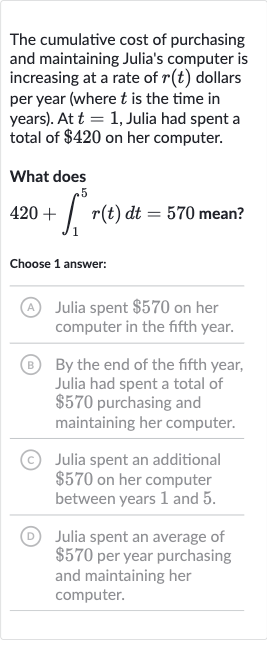AI tutor
Welcome to Bytelearn!
Let’s check out your problem:

The cumulative cost of purchasing and maintaining Julia's computer is increasing at a rate of dollars per year (where is the time in years). At , Julia had spent a total of on her computer.What does mean?Choose answer:(A) Julia spent on her computer in the fifth year.(B) By the end of the fifth year, Julia had spent a total of purchasing and maintaining her computer.(C) Julia spent an additional on her computer between years and .(D) Julia spent an average of per year purchasing and maintaining her computer.
Full solution
Q. The cumulative cost of purchasing and maintaining Julia's computer is increasing at a rate of dollars per year (where is the time in years). At , Julia had spent a total of on her computer.What does mean?Choose answer:(A) Julia spent on her computer in the fifth year.(B) By the end of the fifth year, Julia had spent a total of purchasing and maintaining her computer.(C) Julia spent an additional on her computer between years and .(D) Julia spent an average of per year purchasing and maintaining her computer.
- Given Equation Interpretation: We are given the equation . This equation includes an integral, which represents the total additional cost from time to . The initial value represents the total cost at . The equation is setting the sum of the initial cost and the additional cost over the next four years equal to .
- Integral Meaning: To understand what the equation means, we need to interpret the integral. The integral represents the total additional cost of purchasing and maintaining the computer from year to year . It does not represent the cost in any single year, but the cumulative additional cost over those years.
- Total Cost Calculation: Adding the initial cost of to the integral gives us the total cost by the end of year . Therefore, the equation means that by the end of the fifth year, Julia had spent a total of on her computer.
- Answer Choice Evaluation A: Now we can evaluate the answer choices given:(A) This choice suggests that Julia spent in the fifth year alone, which is incorrect because the integral represents the cumulative additional cost from years to , not the cost in the fifth year only.
- Answer Choice Evaluation B: (B) This choice is correct because it states that by the end of the fifth year, Julia had spent a total of on her computer, which is exactly what the equation represents.
- Answer Choice Evaluation C: (C) This choice is incorrect because it suggests that Julia spent an additional between years and , but the total amount spent by the end of year is , not the additional amount spent.
- Answer Choice Evaluation D: (D) This choice is incorrect because it suggests an average yearly cost, which cannot be determined from the given equation without additional information about the function .
